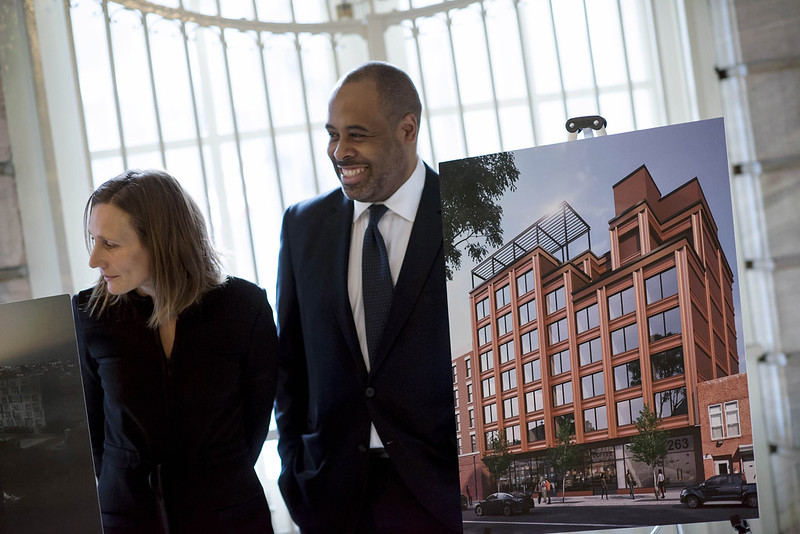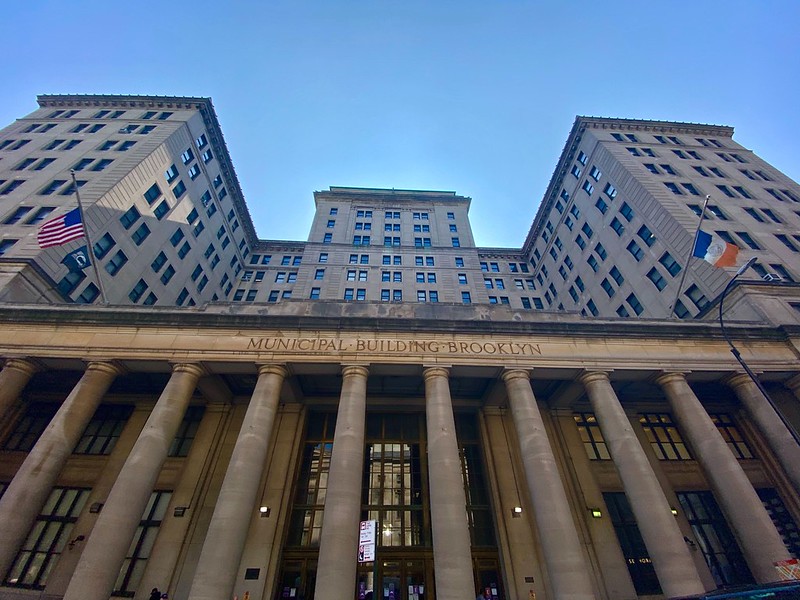Protect New York City's Supportive Housing Providers in the Face of a Mounting Crisis

Housing at stake (photo: Ed Reed/Mayoral Photography Office)
New York City’s nonprofit supportive housing community, which has for decades successfully provided deeply affordable housing to formerly unhoused and low-income individuals, is increasingly endangered by New York’s mounting housing crisis.
Study after study has shown that supportive housing – a combination of affordable housing and voluntary services like case management and mental health and addiction counseling – is the most effective method to combat chronic homelessness and put people on the path to healthy, independent living. Maintaining that track record of success requires consistent funding, a well-trained and competitively compensated workforce, and a flexible and responsive continuum of care for tenants with the most acute needs.
As a form of independent rental housing – not a residential or treatment program – supportive housing tenants sign a lease upon moving in, which typically requires them to pay 30% of whatever income they have toward rent. This is in line with the federal affordability standard and is critical to support nonprofit providers’ financial solvency and their ability to provide vital services.
Operating on razor-thin margins, providers must rely on timely rent payments to keep the lights on and staff paid, and they partner with all levels of government to offer dramatically reduced rents to the households in most need.
Today, supportive housing and low-income tenants are struggling. It’s estimated that nearly one in three tenants in affordable housing owes back rent, adding up to nearly $2 billion in missing rent payments. More than 70,000 NYCHA tenants alone owe a total of $466 million in back rent. While NYCHA’s fiscal crisis has been widely reported, less attention has been given to the similar fate nonprofit housing providers face if relief from government partners is not provided.
In supportive housing, nonpayment of rent is one of the first indications that tenants may be in crisis. Good providers have layers of systems in place to help tenants get back on track. They collaborate with the onsite social service provider to problem solve - including creating manageable payment plans. This engagement often works, obviating the need for further action.
When tenants cannot or will not work with service providers, the only available option is applying for a “one shot deal” (OSD) from the city. This covers the amount tenants are in arrears so they can remain housed, and buildings can continue to operate. To apply for an OSD, tenants must file a cash assistance case with the Human Resources Administration (HRA). While it is not an official policy to have a Housing Court case to get an OSD, it is the experience of nonprofit providers that demonstrating imminent risk of eviction through a filed court case does support one’s chances of getting assistance.
The court proceedings that trigger the OSD approvals are often done with the tenant’s knowledge that the purpose is to ensure arrears are paid and they aren’t displaced. These proceedings almost never result in actual evictions.
It is unclear to what extent the recent addition of $391 million in state Emergency Rental Assistance Program (ERAP) funding will impact the existing need among supportive housing tenants.
Meanwhile, nonprofit supportive housing providers are doing whatever they can to cope with an avalanche of challenges. These include 30% staff vacancy rates as well as significantly increased tenant need. Adding massive rental arrears to their already precarious situations is putting providers – as well as their tenants - at serious risk.
Everything should be on the table to ensure providers are made whole and tenants stay housed. That includes examining a better process so formerly homeless tenants with significant arrears can quickly and seamlessly access the financial support they need. We understand and appreciate that HRA is willing to work with the supportive housing community on systemic fixes, which may include seeking changes to regulatory requirements that determine eligibility to improve this process.
At a time where the city’s shelter population is at unprecedented heights, we must protect existing housing for formerly homeless New Yorkers and build more of it. If we fail to act quickly, it will be difficult – if not outright impossible – for the city to successfully address its homelessness, mental health, and housing crises.
***
Pascale Leone is Executive Director of the Supportive Housing Network of NY. Catherine Trapani is Executive Director at Homeless Services United. On Twitter @theNetworkNY & @HSUNYC.
***
Have an op-ed idea or submission for Gotham Gazette? Email This email address is being protected from spambots. You need JavaScript enabled to view it.
I’ve Worked in Times Square for 18 Years; A Fresh Entertainment Destination – with Gaming – is the Change the Neighborhood Needs

Rendering of a proposed Times Square casino
In 1998, I started selling clothing at the corner of 45th and Broadway in the heart of Times Square. Back then, the neighborhood was chaotic, overwhelming, and a little bit scary. In the 2000s, the area was a target of global violence, as well: On May 1, 2010, a Nissan Pathfinder parked near my stand began emitting smoke. I joined a handful of other vendors in alerting the NYPD, who eventually found and disassembled an explosive device made up of two full 5-gallon cans of gasoline, three full 20-gallon propane tanks, and more than 250 pounds of fertilizer. Times Square – and all of New York – dodged a bullet that day.
Fast forward 13 years, and Times Square has undergone a remarkable transformation.
As I walk to my stand today, I can't help but marvel at how different the area looks and feels from when I first arrived. The quality of ground-level retail has also gone up dramatically. The iconic peep shows, once synonymous with Times Square, have given way to clothing stores, souvenir shops, and restaurants. A once-seedy portion of the city has become a family-friendly magnet for visitors.
Still, I can't help but feel that there is more work to be done. While the city's efforts to improve safety and security in Times Square have been commendable, there is still a sense of economic unease that lingers in the air. The two engines of Times Square’s economy have always been tourists and office workers, both of which were hampered significantly by the COVID-19 pandemic. Now, many of the tourists have returned, but the switch to hybrid work has left a real dent in the neighborhood.
In the midst of this uncertainty, I’m struck by the need for further development. The prospect of a once-in-a-lifetime entertainment destination opening in the area – Caesars Palace Times Square – is generating buzz, and for good reason.
Caesars’ proposal for a new gaming venue at 1515 Broadway, in partnership with real estate developer SL Green and Jay-Z’s Roc Nation, would bring a brand-new flagship to what is already New York’s best entertainment destination. This project would generate an influx of visitors, providing a much-needed boost to theaters, hotels, restaurants, and retailers in the area.
Caesars Entertainment, SL Green, and Roc Nation are also promising a multi-million-dollar investment in Times Square, including congestion mitigation efforts, improved safety, and better sanitation.
The impact of this partnership would extend far beyond the casino itself, benefitting the entire community and funding a wide range of neighborhood initiatives and improvements to make Times Square the safest, cleanest, and most pedestrian-friendly entertainment district in the world.
I have seen Times Square at its best and at its worst. A new, state-of-the-art entertainment destination like Caesars Palace Times Square is exactly the kind of innovative development that can keep the neighborhood on the right track. Times Square thrives on change, and this is the change that we need.
***
Duane Jackson is a vendor in Times Square.
***
Have an op-ed idea or submission for Gotham Gazette? Email This email address is being protected from spambots. You need JavaScript enabled to view it.
Civil Justice Reform Can Help Accomplish Progressive Goals

Municipal Building Brooklyn (photo: Michael Appleton/Mayoral Photography Office)
New York’s broken civil justice system is holding back progress.
Civil justice reform is often unfairly maligned. In reality, most common-sense legal reform initiatives align with progressive goals and values that benefit all New Yorkers.
Civil justice reform targets the financial incentives that often drive excess lawsuits. A relative handful of people currently abuse the civil justice system for economic gain. Lawyers rake in millions from the injured and most vulnerable members of our society. Personal injury firms advertise heavily on daytime TV, near construction sites, and even target emergency rooms with digital ads. According to a study published by the RAND Corporation, personal injury claims are disproportionately filed by residents of the poorest neighborhoods, with attorneys consistently taking 33% of every settlement.
Then there are the financiers, unregulated consumer lawsuit lending outfits and hedge funds that invest in lawsuits, turning the civil justice system into a tool for predatory lending. Interest rates on lawsuit loans have exceeded 100% interest and bankrolled some of the worst abuses of our civil justice system. In addition, these third-party lenders can drag out litigation, the judge and jury unaware that a third party is working behind the scenes. These practices incentivize speculative lawsuits that clog up the courts for those who really need them. Progressives seek to protect the vulnerable. Regulating predatory lawsuit lending would be a good place to start.
Due to our liability system, New York is the most expensive place to build on the planet. The state’s unique Scaffold Law, dating back to the 19th century, holds property owners and contractors 100% liable for any injuries sustained on job sites, even when they were not primarily at fault. With money and resources tied up in liability, investments aren’t made in progressive goals like repairing and updating schools, building affordable housing, or expanding wind, solar, and other renewable energy sources.
Any person or business causing harm to others should be held accountable, but due to our permissive laws, profit-seeking lawyers often target innocent people. If someone trespasses on private property, breaks the law, and injures themselves, the property owner will likely get slapped with a lawsuit. There must be changes made to the law prohibiting trespassers from suing for injuries sustained while trespassing, but we should also ensure that these reforms – which would reduce expensive lawsuits that increase homeowners’ insurance and costs to municipalities – also protect children. This includes children who may have found the neighbor’s unsecured swimming pool appealing and children hurt due to homeowners’ negligence.
A truly progressive state must have affordable and equitable health care in all communities. In New York, the threat of baseless medical liability lawsuits has driven doctors out of our state and contributed to the nursing shortage crisis. Fewer doctors threaten access to care for our most vulnerable communities. Doctors worry that just practicing in places like the Bronx can “destroy their careers.”
Even when medical care is accessible, it is wildly expensive, due in large part to liability costs. New York has the country's highest medical liability payout costs, both overall and per capita. And some legislative proposals could make the situation worse. This is both expensive for patients and makes it difficult for New York to attract the best doctors.
The core of our civil justice system is to protect individuals and ensure the scales of justice remain balanced. Common sense legal reforms will prevent unnecessary lawsuits, reduce medical costs, improve access to the courts and medical care, and help us build more affordable housing and realize the state’s renewable energy goals. The current system is weighted towards wealthy and politically connected lawyers. It needs to work for the rest of us.
***
Ruvi Lopez is grassroots manager at the Lawsuit Reform Alliance of New York. On Twitter @LawsuitReformNY.
***
Have an op-ed idea or submission for Gotham Gazette? Email This email address is being protected from spambots. You need JavaScript enabled to view it.




